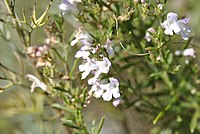
Photo from wikipedia
Antimicrobial resistance (AMR) poses a serious threat to human health, and new antimicrobial agents are desperately needed. Plant flavonoids are increasingly being paid attention to for their antibacterial activities, for… Click to show full abstract
Antimicrobial resistance (AMR) poses a serious threat to human health, and new antimicrobial agents are desperately needed. Plant flavonoids are increasingly being paid attention to for their antibacterial activities, for the enhancing of the antibacterial activity of antimicrobials, and for the reversing of AMR. To obtain more scientific and reliable equations, another two regression equations, between the minimum inhibitory concentration (MIC) (y) and the lipophilicity parameter ACD/LogP or LogD7.40 (x), were established once again, based on the reported data. Using statistical methods, the best one of the four regression equations, including the two previously reported, with regard to the antimicrobial quantitative relationship of plant flavonoids to Gram-positive bacteria, is y = −0.1285 x6 + 0.7944 x5 + 51.785 x4 − 947.64 x3 + 6638.7 x2 − 21,273 x + 26,087; here, x is the LogP value. From this equation, the MICs of most plant flavonoids to Gram-positive bacteria can be calculated, and the minimum MIC was predicted as approximately 0.9644 μM and was probably from 0.24 to 0.96 μM. This more reliable equation further proved that the lipophilicity is a key factor of plant flavonoids against Gram-positive bacteria; this was further confirmed by the more intuitive evidence subsequently provided. Based on the antibacterial mechanism proposed in our previous work, these also confirmed the antibacterial mechanism: the cell membrane is the major site of plant flavonoids acting on the Gram-positive bacteria, and this involves the damage of the phospholipid bilayers. The above will greatly accelerate the discovery and application of plant flavonoids with remarkable antibacterial activity and the thorough research on their antimicrobial mechanism.
Journal Title: Pharmaceuticals
Year Published: 2022
Link to full text (if available)
Share on Social Media: Sign Up to like & get
recommendations!